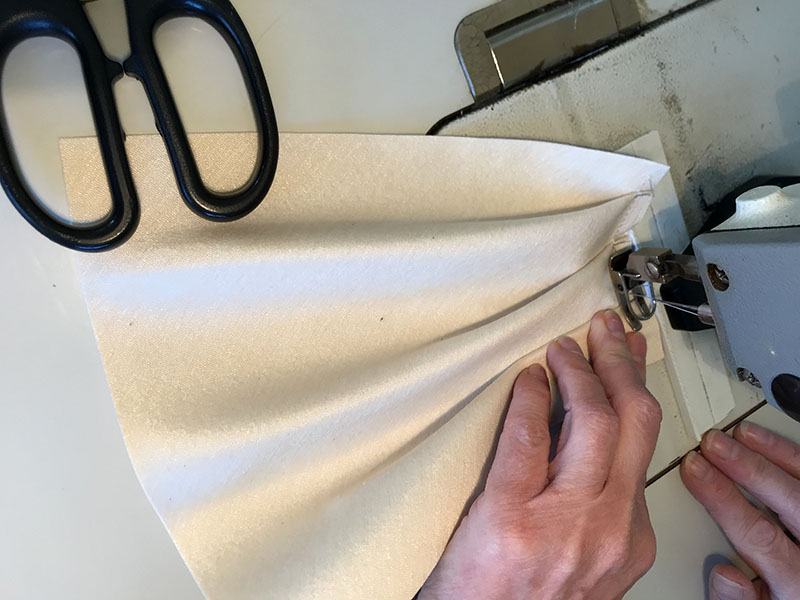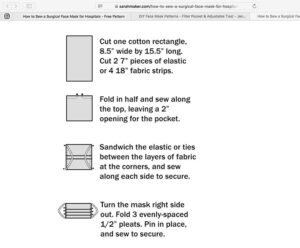Covid-19 Response: Making Face Masks

In contradicting what we’ve been taught until now – that face masks are not useful – I fully expect this post to be controversial. But too much is at stake, so please read on with an open mind.
The good news from Seattle is that our current lockdown seems to be working. New infections appear to be leveling off. It’s too early to tell whether this will last, but it’s encouraging: We aren’t powerless. We can change the trajectory of this pandemic. Unfortunately, the situation is more difficult in many places, and our thoughts go out to all who are affected. It’s a scary time!
And yet we must focus on the future. Now is the time to prepare for the fight against the virus after we start returning to normal life. The ‘shelter-in-place’ orders reset the clock by reducing transmissions, while we try to figure out who is infected and who is not. Once we come out of the lockdowns, the virus will still be in the community. There will be fewer carriers, but many will be asymptomatic.
What may seem like bad news – this won’t be over for a long time – is also good news: We get another chance. And this time, we can take measures that – hopefully – will contain the virus before we need to take drastic measures – such as lockdowns – again. We all want to return to our normal lives. The more we prepare and get it right this time, the more we will be able not just to return to normal, but also remain at normal.
This is where everybody has to help. What can we do? The obvious is continue safe practices:
- Take social distancing seriously.
- Wash our hands frequently (and for the full 40 seconds).
- Disinfect surfaces that we touch before we can wash our hands. Keep our bathrooms clean (and separate, where possible).
- Wear masks when we are out in public. (Yes, really!)
Masks appear to be one of several reasons why infections did not spike as rapidly in Hong Kong, South Korea and Singapore. Everybody there wore masks during the outbreak, making the social distancing more effective.
The evidence on this is clear: Scientific studies have shown that a surgical mask will reduce exposure to airborne viruses, on average by a factor of 6. What does this mean? It means that masks don’t offer 100% protection, but they greatly reduce how much you’ll be exposed to the virus. And with Covid-19, it appears that the amount of your exposure is important. That’s why the virus spreads in clusters among co-workers, family members and – sadly – health care workers. The more exposed you are, the more likely you are to get infected. Reducing our exposure apparently reduces the risk to get infected.
Now Health experts are rethinking the guidelines. Several papers in scientific journals like Science and The Lancet recommend wearing masks. The head of the Chinese CDC said: “The big mistake in the U.S. and Europe, in my opinion, is that people aren’t wearing masks.”
Masks are not just effective in protecting the wearer (ourselves), they are also crucial in protecting others by catching the droplets that transmit the virus. Natsuko told me: “In Japan, we are expected to wear a mask when we have a cold or don’t feel well, to protect others. And if the flu is especially bad, we also should wear a mask to protect ourselves.” The Coronavirus is not the flu, but it is also transmitted via droplets that we exhale.
In fact, the CDC has always recommended wearing a mask if you are infected. But we don’t know who is infected – that is why we have the current lockdown – so it makes sense for everybody to wear masks. That way, those who are infected, and don’t know it, will wear masks, too.
The CDC also recommends wearing masks when you are around somebody who is infected. Again, we don’t know who is infected, so we should wear masks when we meet anybody. And like immunizations, this works best when everybody works together to control the spread of the virus.
Masks add an extra layer to social distancing, reducing the exposure when we come too close for safety – which is unavoidable, for example, at a grocery store checkout counter. As an added benefit, masks remind us when we touch our faces – a habit that many of us have to break right now. (Resist the temptation to adjust your mask constantly – you should touch it as little as possible.)
Cyclists will understand the value of making small, but meaningful, performance improvements: A set of supple tires will not make you a world champion, but it’ll make a noticeable difference even on a casual ride. Even the most home-made mask provides more benefits than the ‘marginal gains’ that many cyclists are chasing.
You may wonder: Why did we get such strongly worded recommendations not to wear masks in the first place? There were two apparent reasons:
- There is a shortage of masks, and the message that masks are ineffective was intended to prevent people from buying precious stocks. (They are needed for front-line health care workers.) That backfired, and hopefully, those responsible have learned the lesson that transparency is the best policy.
- Officials worried about the economic impact of the crisis. Just a few weeks ago, Seattle’s mayor complained that news of the outbreak were scaring away tourists. People wearing masks would have been an very visible reminder that the virus was already spreading in our community. In hindsight, that might have been good. It might have create a sense of urgency that was lacking during the early days of the pandemic.
So we agree that masks are an effective tool in slowing the spread of the virus. Yet during the current shortage, there are no masks available. And the few masks that we have should go to the medical teams first. But we can make our own masks. Many already have taken the initiative to make much-needed masks for hospitals and nursing homes. What I suggest is that we expand this effort so that everybody comes out of the current lockdown with a mask or two.
How effective are home-made masks? A study found that home-made masks “significantly reduced the number of microorganisms expelled by volunteers.” In fact, the CDC now recommends that health care workers cover their mouth and nose with scarves when masks aren’t available. We certainly can do better than scarves!

So we now know that masks will be helpful in reducing the spread of the virus, especially after the current restrictions are eased. Let’s get to work making our own! And if you want to do more, make a few extra for your neighbors, friends and others. Some volunteers even make them for medical workers. If you know somebody who likes to sew, get them involved. Natsuko asked her mother to make a few masks. (Her mother was bored because her gym is closed and she is not supposed to meet her friends.) Natsuko’s mom enjoyed the task, and you see the result in the top photo.
FMB, the makers of tubular tires, has been making masks for a local residence for the elderly (above). The ultra-fine weave of the fabric used in tubular tires looks perfect for filtering out most droplets.
There are many patterns and instructions online, like this one. (Thanks, Machiko, for the link!) Sewing a mask is about the easiest sewing project you can do. If you don’t have a sewing machine, you can stitch it by hand.

You can use all kinds of fabric for the outer layer. Masks don’t have to be white or black… Making a mask for everybody during the next few weeks seems like a huge task, but it’s doable. And it will make a difference.
And we’ll keep thinking about what we can do to help. Because we’re all in this together!



